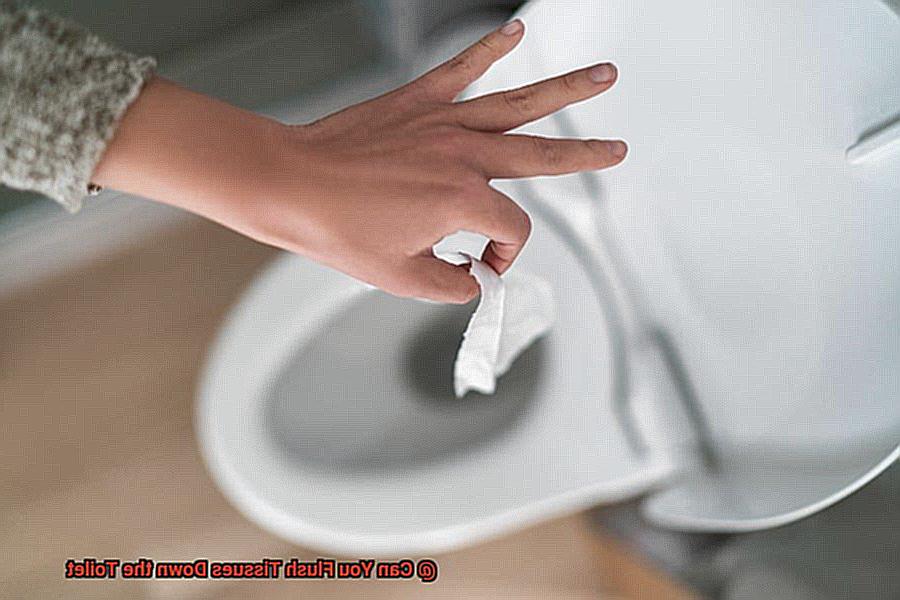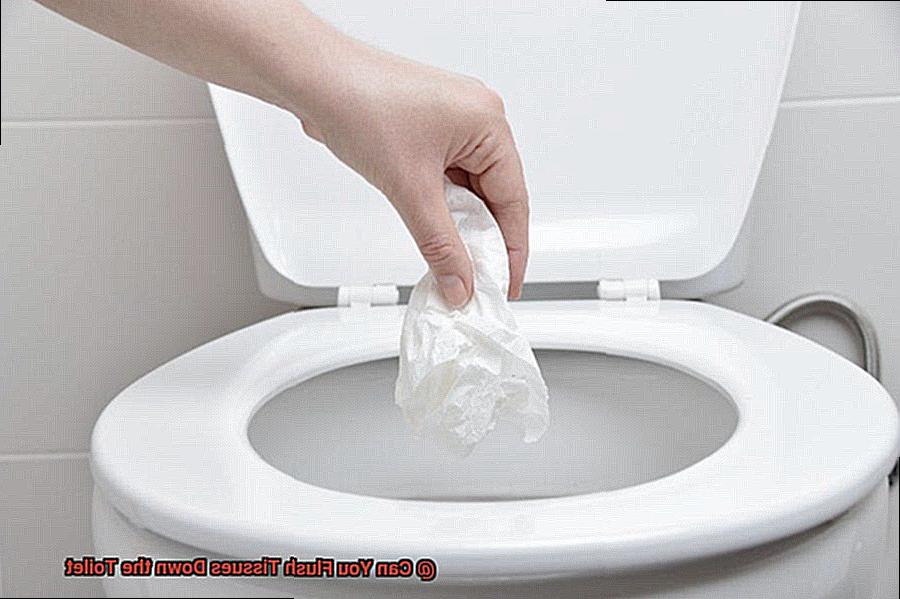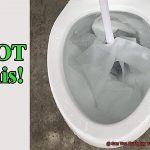Have you ever found yourself in a situation where you need to dispose of tissues and wondered if it’s safe to flush them down the toilet? It’s a question that many of us have pondered, but few have found a clear answer. Well, we’re here to shed some light on this issue.
Let’s start with the basics: regular facial tissues and paper towels should never be flushed down the toilet. They are not designed to dissolve easily in water and can cause serious blockages in your pipes. Trust us, you don’t want to deal with the headache of a clogged toilet or backed-up sewage system.
On the other hand, toilet paper is specifically made to be flushed down the toilet. It’s designed to break down quickly and won’t cause any harm to your plumbing or the environment. However, it’s important to only flush small amounts at a time to avoid any potential issues.
It may seem like a small thing, but improper disposal of tissues can have serious consequences. Flushing anything other than bodily waste and toilet paper can harm our waterways and wildlife. So next time you reach for a tissue, think twice before flushing it away.
In conclusion, remember that not all tissues are created equal when it comes to flushing them down the toilet. Stick with toilet paper and flush responsibly – your plumbing (and the planet) will thank you.
Contents
What is Toilet Paper?
One of these humble yet vital items is toilet paper. Let’s dive into what it is, where it came from, and why it’s so essential.
Toilet paper is a soft, lightweight, and absorbent paper used for cleaning oneself after using the toilet. It comes in various forms such as rolls, sheets, and individual packets. While most brands are made from wood pulp or recycled paper, some use alternative materials like bamboo, hemp, or cotton.
Did you know that Joseph Gayetty gets the credit for inventing modern toilet paper in the 1850s? Initially marketed as a medical product to prevent hemorrhoids, it wasn’t until the 1920s that toilet paper became widely available and affordable for everyone.
Toilet paper is designed to dissolve quickly and easily when flushed, unlike other types of paper products such as tissues or paper towels. Flushing non-toilet paper products can lead to clogged pipes and sewer backups. So, next time you’re thinking about flushing tissue down the toilet instead of throwing it in the trash, think again.
While there has been a growing trend towards using alternative methods like bidets or reusable cloth wipes in recent years, not everyone has access to them. Toilet paper remains the most practical option for most people.
What are Tissues?
Although most people think of tissues as the soft paper we use to wipe our nose or clean our face, it’s important to note that they also include other absorbent paper products like paper towels, napkins, and baby wipes.
These materials are designed to be more durable and absorbent than toilet paper, making them unsuitable for flushing down the toilet. If flushed, they can cause serious plumbing problems and clog pipes.
It’s worth mentioning that even if the packaging claims that these items are “flushable,” it doesn’t mean they are safe to flush down the toilet. Many plumbing professionals warn against flushing any type of tissue down the toilet other than toilet paper.
To prevent damages to your plumbing system, it’s best to dispose of tissues in the trash can rather than flushing them down the toilet.
Why Flushing Tissues Down the Toilet is Not Recommended
Although it may seem like a convenient way to dispose of them, it can cause several problems that are best avoided.
For starters, tissues aren’t designed to break down in water as quickly as toilet paper. As a result, flushing them down the toilet can lead to clogged pipes and costly repairs. Worse still, flushing tissues can cause blockages in your septic tank or sewer lines, which can leave you dealing with unpleasant backups and overflows.
But that’s not all. Flushing tissues down the toilet also has a negative impact on the environment. Tissues that end up in our waterways can take years to decompose, contributing to pollution and harming marine life. Additionally, the production of tissues requires significant resources and energy, so it’s essential to dispose of them responsibly.
So, what’s the best way to dispose of tissues? It’s simple – toss them in the trash bin instead of flushing them down the toilet. By taking this small step, you’ll be doing your part to protect your plumbing system and the environment while also avoiding costly repairs.
If you’re looking for an even greener option, consider using reusable cloth wipes or recycled toilet paper. Not only will this help reduce waste and save money in the long run, but it’s also an excellent way to be kinder to the environment.
To conclude, flushing tissues down the toilet is not recommended for several reasons. By disposing of them in the trash or using eco-friendly alternatives, you’ll be doing your bit to protect our planet while also avoiding unpleasant plumbing issues.
Potential Problems Caused by Flushing Tissues Down the Toilet
While it may seem like a convenient option, it can have disastrous consequences that can harm both your plumbing system and the environment. As an expert on this topic, I’m here to shed light on the potential issues you may face.
Firstly, tissues are not designed to break down quickly like toilet paper. This means they can cause clogs in your pipes or sewer lines, leading to costly repairs and even damage to your entire plumbing system if not addressed promptly. Don’t let a small mistake lead to a significant financial burden – toss tissues in the trash bin instead.
In addition to clogs, flushing tissues down the toilet can also harm the environment. When flushed, they can make their way into our waterways and contribute to pollution. They take longer to degrade than toilet paper, which means they can accumulate in our sewage systems, leading to blockages and backups. Let’s be mindful of our actions and do our part in keeping our oceans clean by disposing of tissues responsibly.
Moreover, flushing tissues down the toilet can pose a health hazard too. Since tissues are not meant for flushing, they can contain harmful bacteria and viruses that may not be eliminated by wastewater treatment plants.
This can lead to the spread of diseases and infections, especially in areas with poor sanitation practices or inadequate wastewater treatment facilities.
How to Dispose of Tissues Properly
Properly Disposing of Tissues: Protecting Your Plumbing and the Environment
Tissues are an essential part of our daily routine, and it’s important to know how to dispose of them properly. Although it may seem like a no-brainer to flush them down the toilet or toss them in the trash, neither option is ideal. Here are five ways to dispose of tissues properly to avoid causing harm to the environment and clogging your plumbing system.
Trash Can
The most straightforward way to dispose of tissues is by throwing them in the trash. However, be sure to use a tissue or paper towel to grab any used tissues so that you don’t come into contact with any germs. Once you have used the tissue, place it in the trash can and wash your hands thoroughly.
Composting
If you have a compost bin or pile, natural material tissues such as bamboo or cotton can be added to it as long as they have only been used for blowing your nose. Composted tissues can help fertilize your garden and reduce landfill waste.
Lidded Trash Can
If you’re worried about germs or odors, consider using a small lidded trash can with a liner that can be changed regularly. Place the waste bin in a convenient location, such as near the toilet or sink, to make it easy for everyone to use.
Don’t Flush
Flushing tissues can lead to clogs and blockages in pipes and sewer systems, which can cause expensive damage and backups. Tissues are made of paper and are not designed to break down in water the same way toilet paper does. Instead, throw them in the trash.
Follow Special Disposal Guidelines
Some tissues may be contaminated with bodily fluids or other materials that require special disposal methods. For example, tissues used to wipe up blood or other bodily fluids should be placed in a sealed bag before being thrown away. Check with your local waste management agency for specific guidelines on how to dispose of these types of materials safely and responsibly.

By properly disposing of tissues, you can help prevent clogs and blockages in your plumbing system, as well as reduce the risk of spreading germs and contaminants.
yRgugtE2vXA” >
Conclusion
In conclusion, it’s vital to recognize that flushing tissues down the toilet can lead to serious plumbing problems and environmental harm. Unlike toilet paper, tissues, paper towels, and other absorbent materials are not designed to dissolve quickly and safely in water. So, it’s crucial to dispose of them properly.
To avoid costly repairs and protect our planet, we must throw tissues in the trash or compost natural material tissues such as bamboo or cotton. Additionally, special disposal guidelines should be followed for contaminated tissues.
While most people prefer toilet paper, there is a growing trend towards eco-friendly options like bidets or reusable cloth wipes. These alternatives not only reduce waste but also save money in the long run while being kinder to the environment.
In summary, responsible tissue disposal is essential for protecting our plumbing system and preventing pollution of our waterways. By tossing them in the trash bin or composting natural material tissues, we can contribute to a healthier planet for generations to come.






